Marketing Plan of Toyota Prius
VerifiedAdded on 2023/06/12
|15
|3921
|301
AI Summary
This marketing plan outlines the current market and situational analysis of Toyota Prius, including its competitive analysis and consumer behavior. It also recommends marketing mix strategies and budget plans.
Contribute Materials
Your contribution can guide someone’s learning journey. Share your
documents today.
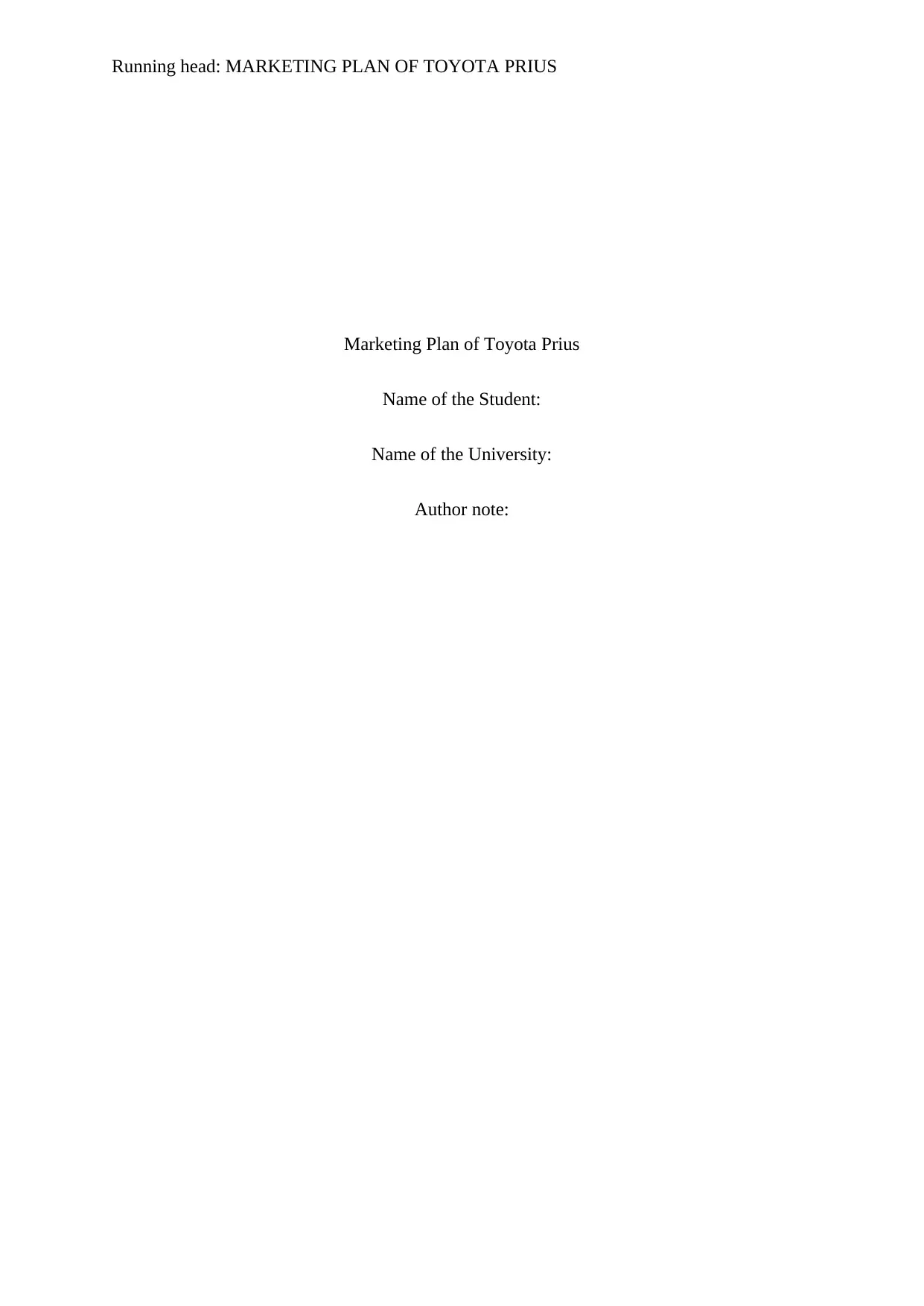
Running head: MARKETING PLAN OF TOYOTA PRIUS
Marketing Plan of Toyota Prius
Name of the Student:
Name of the University:
Author note:
Marketing Plan of Toyota Prius
Name of the Student:
Name of the University:
Author note:
Secure Best Marks with AI Grader
Need help grading? Try our AI Grader for instant feedback on your assignments.
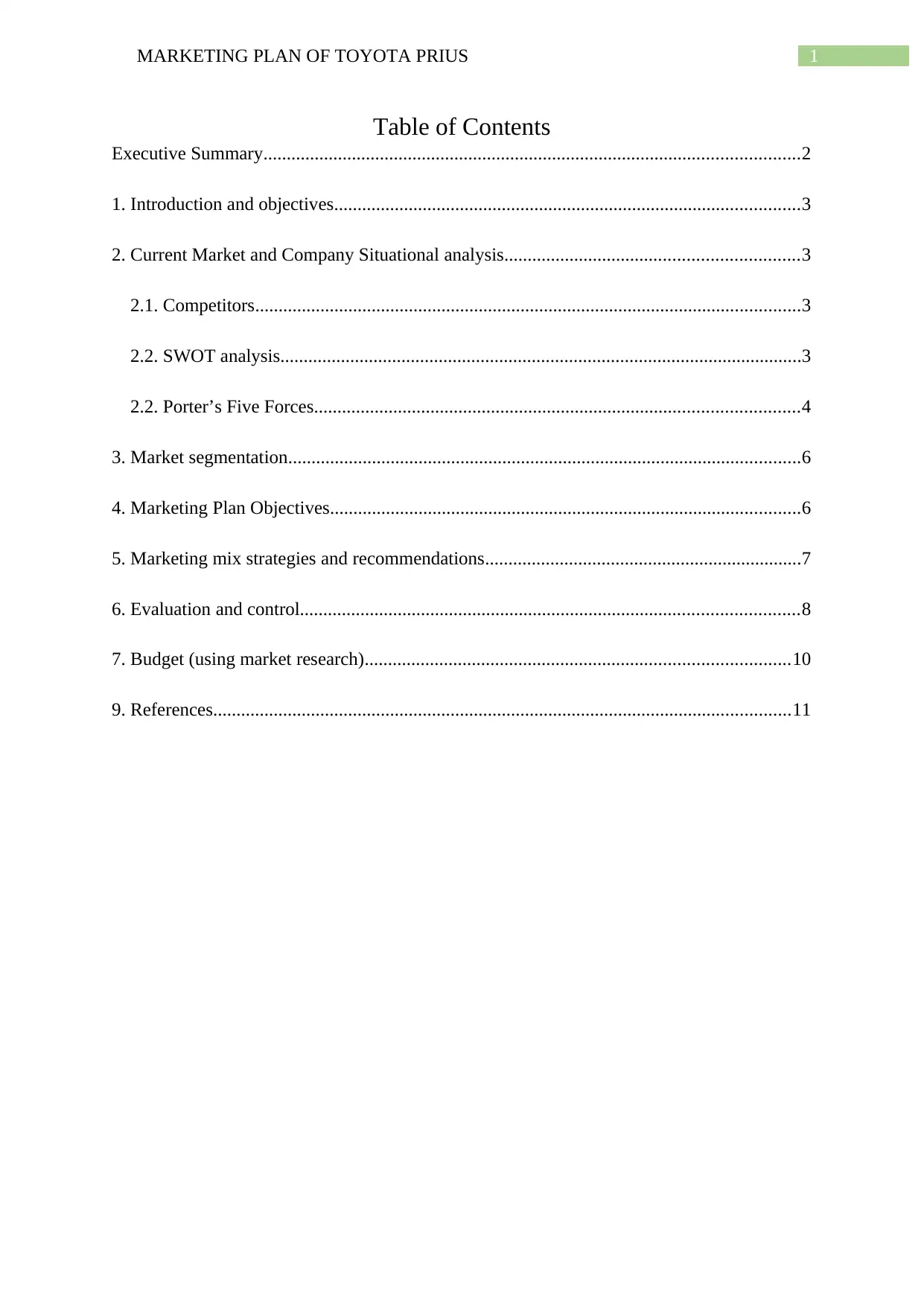
1MARKETING PLAN OF TOYOTA PRIUS
Table of Contents
Executive Summary...................................................................................................................2
1. Introduction and objectives....................................................................................................3
2. Current Market and Company Situational analysis...............................................................3
2.1. Competitors.....................................................................................................................3
2.2. SWOT analysis................................................................................................................3
2.2. Porter’s Five Forces........................................................................................................4
3. Market segmentation..............................................................................................................6
4. Marketing Plan Objectives.....................................................................................................6
5. Marketing mix strategies and recommendations....................................................................7
6. Evaluation and control...........................................................................................................8
7. Budget (using market research)...........................................................................................10
9. References............................................................................................................................11
Table of Contents
Executive Summary...................................................................................................................2
1. Introduction and objectives....................................................................................................3
2. Current Market and Company Situational analysis...............................................................3
2.1. Competitors.....................................................................................................................3
2.2. SWOT analysis................................................................................................................3
2.2. Porter’s Five Forces........................................................................................................4
3. Market segmentation..............................................................................................................6
4. Marketing Plan Objectives.....................................................................................................6
5. Marketing mix strategies and recommendations....................................................................7
6. Evaluation and control...........................................................................................................8
7. Budget (using market research)...........................................................................................10
9. References............................................................................................................................11
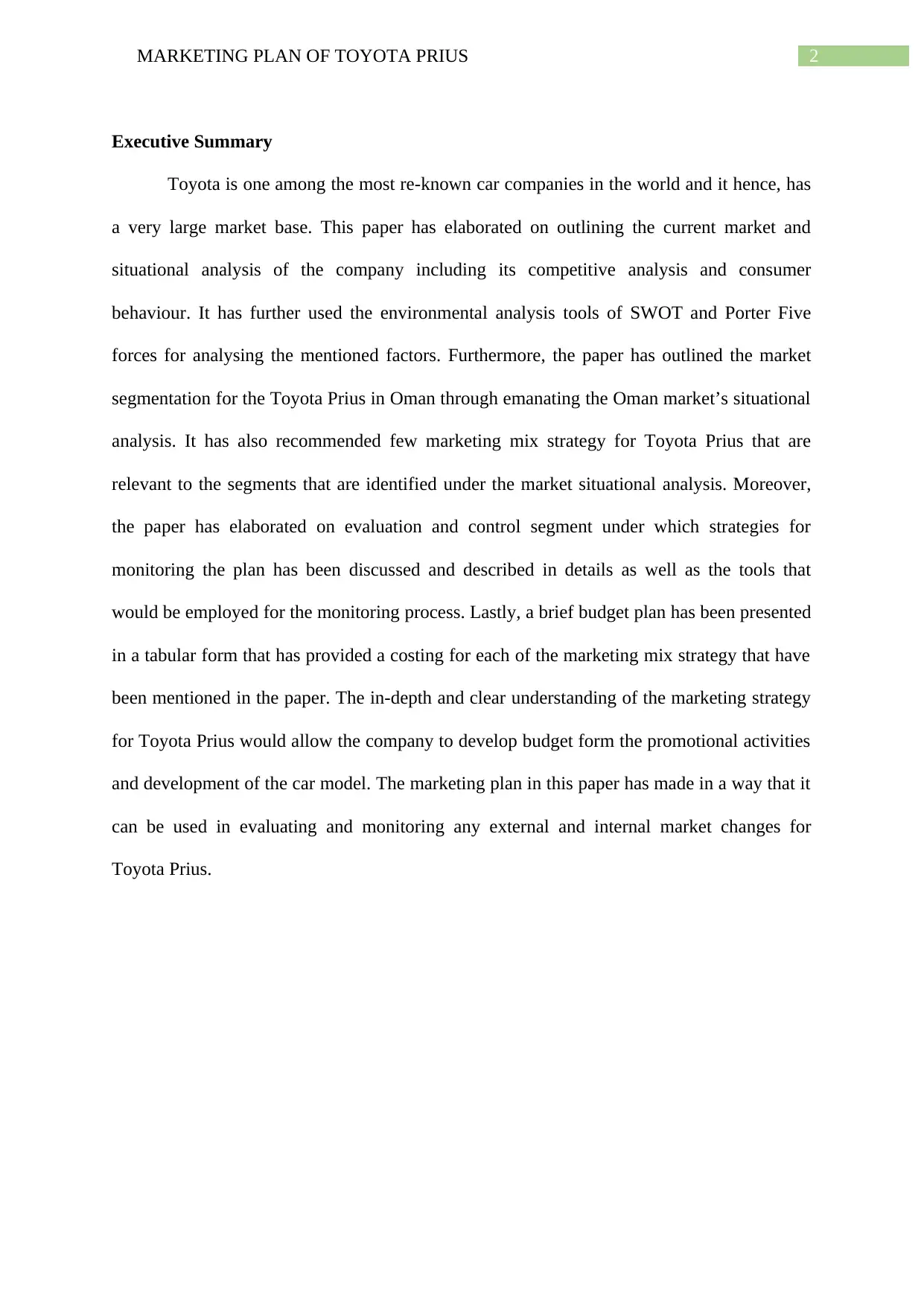
2MARKETING PLAN OF TOYOTA PRIUS
Executive Summary
Toyota is one among the most re-known car companies in the world and it hence, has
a very large market base. This paper has elaborated on outlining the current market and
situational analysis of the company including its competitive analysis and consumer
behaviour. It has further used the environmental analysis tools of SWOT and Porter Five
forces for analysing the mentioned factors. Furthermore, the paper has outlined the market
segmentation for the Toyota Prius in Oman through emanating the Oman market’s situational
analysis. It has also recommended few marketing mix strategy for Toyota Prius that are
relevant to the segments that are identified under the market situational analysis. Moreover,
the paper has elaborated on evaluation and control segment under which strategies for
monitoring the plan has been discussed and described in details as well as the tools that
would be employed for the monitoring process. Lastly, a brief budget plan has been presented
in a tabular form that has provided a costing for each of the marketing mix strategy that have
been mentioned in the paper. The in-depth and clear understanding of the marketing strategy
for Toyota Prius would allow the company to develop budget form the promotional activities
and development of the car model. The marketing plan in this paper has made in a way that it
can be used in evaluating and monitoring any external and internal market changes for
Toyota Prius.
Executive Summary
Toyota is one among the most re-known car companies in the world and it hence, has
a very large market base. This paper has elaborated on outlining the current market and
situational analysis of the company including its competitive analysis and consumer
behaviour. It has further used the environmental analysis tools of SWOT and Porter Five
forces for analysing the mentioned factors. Furthermore, the paper has outlined the market
segmentation for the Toyota Prius in Oman through emanating the Oman market’s situational
analysis. It has also recommended few marketing mix strategy for Toyota Prius that are
relevant to the segments that are identified under the market situational analysis. Moreover,
the paper has elaborated on evaluation and control segment under which strategies for
monitoring the plan has been discussed and described in details as well as the tools that
would be employed for the monitoring process. Lastly, a brief budget plan has been presented
in a tabular form that has provided a costing for each of the marketing mix strategy that have
been mentioned in the paper. The in-depth and clear understanding of the marketing strategy
for Toyota Prius would allow the company to develop budget form the promotional activities
and development of the car model. The marketing plan in this paper has made in a way that it
can be used in evaluating and monitoring any external and internal market changes for
Toyota Prius.
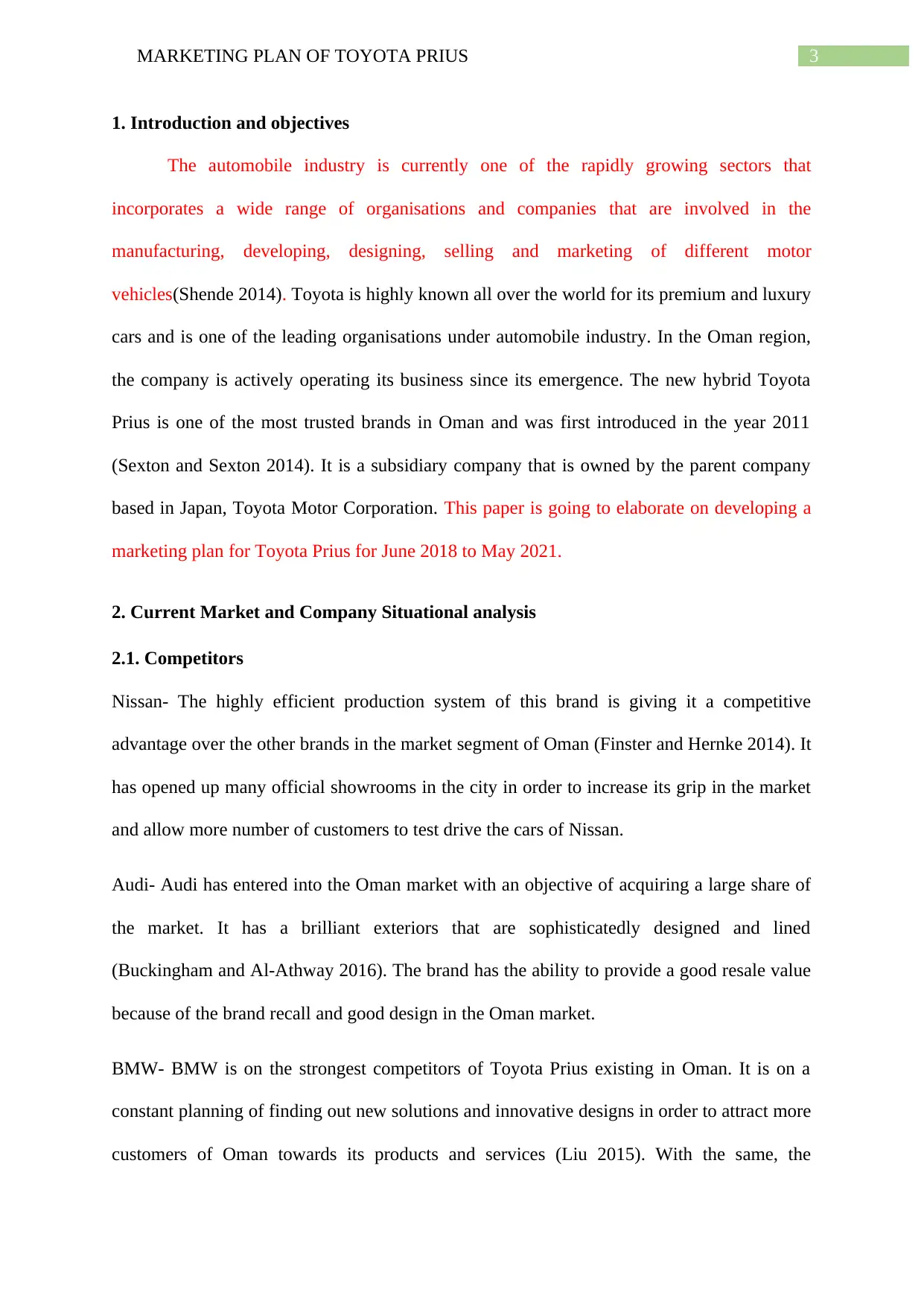
3MARKETING PLAN OF TOYOTA PRIUS
1. Introduction and objectives
The automobile industry is currently one of the rapidly growing sectors that
incorporates a wide range of organisations and companies that are involved in the
manufacturing, developing, designing, selling and marketing of different motor
vehicles(Shende 2014). Toyota is highly known all over the world for its premium and luxury
cars and is one of the leading organisations under automobile industry. In the Oman region,
the company is actively operating its business since its emergence. The new hybrid Toyota
Prius is one of the most trusted brands in Oman and was first introduced in the year 2011
(Sexton and Sexton 2014). It is a subsidiary company that is owned by the parent company
based in Japan, Toyota Motor Corporation. This paper is going to elaborate on developing a
marketing plan for Toyota Prius for June 2018 to May 2021.
2. Current Market and Company Situational analysis
2.1. Competitors
Nissan- The highly efficient production system of this brand is giving it a competitive
advantage over the other brands in the market segment of Oman (Finster and Hernke 2014). It
has opened up many official showrooms in the city in order to increase its grip in the market
and allow more number of customers to test drive the cars of Nissan.
Audi- Audi has entered into the Oman market with an objective of acquiring a large share of
the market. It has a brilliant exteriors that are sophisticatedly designed and lined
(Buckingham and Al-Athway 2016). The brand has the ability to provide a good resale value
because of the brand recall and good design in the Oman market.
BMW- BMW is on the strongest competitors of Toyota Prius existing in Oman. It is on a
constant planning of finding out new solutions and innovative designs in order to attract more
customers of Oman towards its products and services (Liu 2015). With the same, the
1. Introduction and objectives
The automobile industry is currently one of the rapidly growing sectors that
incorporates a wide range of organisations and companies that are involved in the
manufacturing, developing, designing, selling and marketing of different motor
vehicles(Shende 2014). Toyota is highly known all over the world for its premium and luxury
cars and is one of the leading organisations under automobile industry. In the Oman region,
the company is actively operating its business since its emergence. The new hybrid Toyota
Prius is one of the most trusted brands in Oman and was first introduced in the year 2011
(Sexton and Sexton 2014). It is a subsidiary company that is owned by the parent company
based in Japan, Toyota Motor Corporation. This paper is going to elaborate on developing a
marketing plan for Toyota Prius for June 2018 to May 2021.
2. Current Market and Company Situational analysis
2.1. Competitors
Nissan- The highly efficient production system of this brand is giving it a competitive
advantage over the other brands in the market segment of Oman (Finster and Hernke 2014). It
has opened up many official showrooms in the city in order to increase its grip in the market
and allow more number of customers to test drive the cars of Nissan.
Audi- Audi has entered into the Oman market with an objective of acquiring a large share of
the market. It has a brilliant exteriors that are sophisticatedly designed and lined
(Buckingham and Al-Athway 2016). The brand has the ability to provide a good resale value
because of the brand recall and good design in the Oman market.
BMW- BMW is on the strongest competitors of Toyota Prius existing in Oman. It is on a
constant planning of finding out new solutions and innovative designs in order to attract more
customers of Oman towards its products and services (Liu 2015). With the same, the
Secure Best Marks with AI Grader
Need help grading? Try our AI Grader for instant feedback on your assignments.

4MARKETING PLAN OF TOYOTA PRIUS
company is also engaged in both new as well as pre-owned luxury car segments that is
allowing the business of the company to have more affect in the luxury car segment of the
company.
2.2. SWOT analysis
1. Strengths-One of the major strengths of the Toyota Prius is that the brand is
environment conscious and also provides reduced carbon emission (Finster and
Hernke 2014). In Oman, Toyota Prius is equipped with latest models of cars that is
opening up a wide number of choices for the citizen. With the same, it is also to note
that the customer service executives of the company are very customer friendly and
they effectively answers every queries of the customers as the company conducts
training programs for them to attend the customers. The supervisors and the
technicians of the company also undergo internal trainings from their regional centre.
2. Weaknesses-Being one of the hybrid models, Toyota Prius, there is a huge demand
for Toyota Prius among the customers but the company is facing challenges in
delivering their orders within the specified time frame. This is considered to be the
biggest weakness of it by the customers. Along with that it is slightly high in price
when compared to the other petrol variants in the Oman market.
3. Opportunities- There are several opportunities present for Toyota Prius in the Oman
region. One of them is that it could highly gain from the first movers’ advantage in
the hybrid segment. With the same, it is to note that Oman is rapidly expanding and it
is expected that the registration of the vehicles in the Oman market would get
increased by 7.5 percent per annum (Tofigh and Abedian 2016). Furthermore, in
political context, Oman’s government of Sultanate has become a refined economic
state that is motivating the entrepreneurships and investments.
company is also engaged in both new as well as pre-owned luxury car segments that is
allowing the business of the company to have more affect in the luxury car segment of the
company.
2.2. SWOT analysis
1. Strengths-One of the major strengths of the Toyota Prius is that the brand is
environment conscious and also provides reduced carbon emission (Finster and
Hernke 2014). In Oman, Toyota Prius is equipped with latest models of cars that is
opening up a wide number of choices for the citizen. With the same, it is also to note
that the customer service executives of the company are very customer friendly and
they effectively answers every queries of the customers as the company conducts
training programs for them to attend the customers. The supervisors and the
technicians of the company also undergo internal trainings from their regional centre.
2. Weaknesses-Being one of the hybrid models, Toyota Prius, there is a huge demand
for Toyota Prius among the customers but the company is facing challenges in
delivering their orders within the specified time frame. This is considered to be the
biggest weakness of it by the customers. Along with that it is slightly high in price
when compared to the other petrol variants in the Oman market.
3. Opportunities- There are several opportunities present for Toyota Prius in the Oman
region. One of them is that it could highly gain from the first movers’ advantage in
the hybrid segment. With the same, it is to note that Oman is rapidly expanding and it
is expected that the registration of the vehicles in the Oman market would get
increased by 7.5 percent per annum (Tofigh and Abedian 2016). Furthermore, in
political context, Oman’s government of Sultanate has become a refined economic
state that is motivating the entrepreneurships and investments.
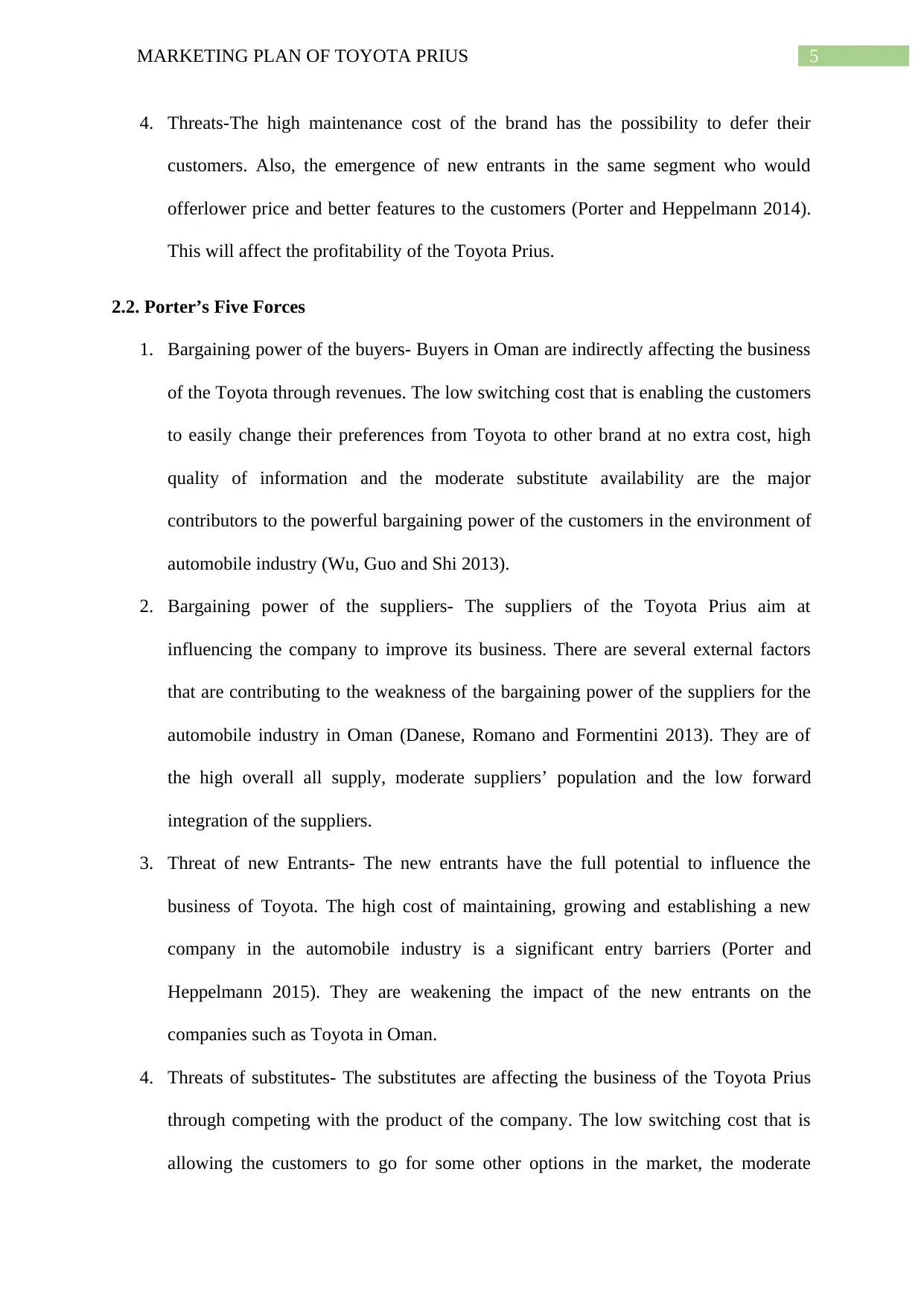
5MARKETING PLAN OF TOYOTA PRIUS
4. Threats-The high maintenance cost of the brand has the possibility to defer their
customers. Also, the emergence of new entrants in the same segment who would
offerlower price and better features to the customers (Porter and Heppelmann 2014).
This will affect the profitability of the Toyota Prius.
2.2. Porter’s Five Forces
1. Bargaining power of the buyers- Buyers in Oman are indirectly affecting the business
of the Toyota through revenues. The low switching cost that is enabling the customers
to easily change their preferences from Toyota to other brand at no extra cost, high
quality of information and the moderate substitute availability are the major
contributors to the powerful bargaining power of the customers in the environment of
automobile industry (Wu, Guo and Shi 2013).
2. Bargaining power of the suppliers- The suppliers of the Toyota Prius aim at
influencing the company to improve its business. There are several external factors
that are contributing to the weakness of the bargaining power of the suppliers for the
automobile industry in Oman (Danese, Romano and Formentini 2013). They are of
the high overall all supply, moderate suppliers’ population and the low forward
integration of the suppliers.
3. Threat of new Entrants- The new entrants have the full potential to influence the
business of Toyota. The high cost of maintaining, growing and establishing a new
company in the automobile industry is a significant entry barriers (Porter and
Heppelmann 2015). They are weakening the impact of the new entrants on the
companies such as Toyota in Oman.
4. Threats of substitutes- The substitutes are affecting the business of the Toyota Prius
through competing with the product of the company. The low switching cost that is
allowing the customers to go for some other options in the market, the moderate
4. Threats-The high maintenance cost of the brand has the possibility to defer their
customers. Also, the emergence of new entrants in the same segment who would
offerlower price and better features to the customers (Porter and Heppelmann 2014).
This will affect the profitability of the Toyota Prius.
2.2. Porter’s Five Forces
1. Bargaining power of the buyers- Buyers in Oman are indirectly affecting the business
of the Toyota through revenues. The low switching cost that is enabling the customers
to easily change their preferences from Toyota to other brand at no extra cost, high
quality of information and the moderate substitute availability are the major
contributors to the powerful bargaining power of the customers in the environment of
automobile industry (Wu, Guo and Shi 2013).
2. Bargaining power of the suppliers- The suppliers of the Toyota Prius aim at
influencing the company to improve its business. There are several external factors
that are contributing to the weakness of the bargaining power of the suppliers for the
automobile industry in Oman (Danese, Romano and Formentini 2013). They are of
the high overall all supply, moderate suppliers’ population and the low forward
integration of the suppliers.
3. Threat of new Entrants- The new entrants have the full potential to influence the
business of Toyota. The high cost of maintaining, growing and establishing a new
company in the automobile industry is a significant entry barriers (Porter and
Heppelmann 2015). They are weakening the impact of the new entrants on the
companies such as Toyota in Oman.
4. Threats of substitutes- The substitutes are affecting the business of the Toyota Prius
through competing with the product of the company. The low switching cost that is
allowing the customers to go for some other options in the market, the moderate
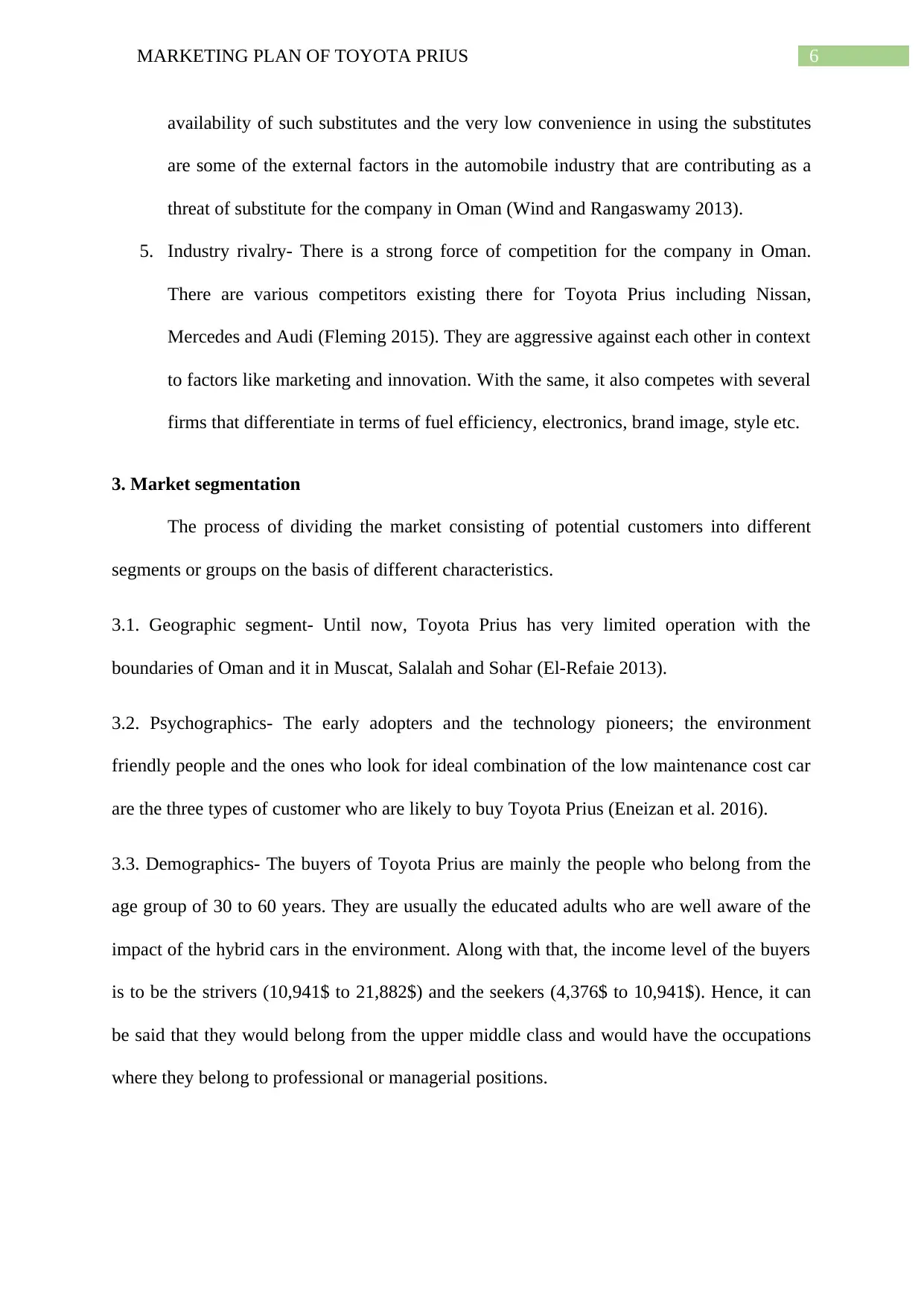
6MARKETING PLAN OF TOYOTA PRIUS
availability of such substitutes and the very low convenience in using the substitutes
are some of the external factors in the automobile industry that are contributing as a
threat of substitute for the company in Oman (Wind and Rangaswamy 2013).
5. Industry rivalry- There is a strong force of competition for the company in Oman.
There are various competitors existing there for Toyota Prius including Nissan,
Mercedes and Audi (Fleming 2015). They are aggressive against each other in context
to factors like marketing and innovation. With the same, it also competes with several
firms that differentiate in terms of fuel efficiency, electronics, brand image, style etc.
3. Market segmentation
The process of dividing the market consisting of potential customers into different
segments or groups on the basis of different characteristics.
3.1. Geographic segment- Until now, Toyota Prius has very limited operation with the
boundaries of Oman and it in Muscat, Salalah and Sohar (El-Refaie 2013).
3.2. Psychographics- The early adopters and the technology pioneers; the environment
friendly people and the ones who look for ideal combination of the low maintenance cost car
are the three types of customer who are likely to buy Toyota Prius (Eneizan et al. 2016).
3.3. Demographics- The buyers of Toyota Prius are mainly the people who belong from the
age group of 30 to 60 years. They are usually the educated adults who are well aware of the
impact of the hybrid cars in the environment. Along with that, the income level of the buyers
is to be the strivers (10,941$ to 21,882$) and the seekers (4,376$ to 10,941$). Hence, it can
be said that they would belong from the upper middle class and would have the occupations
where they belong to professional or managerial positions.
availability of such substitutes and the very low convenience in using the substitutes
are some of the external factors in the automobile industry that are contributing as a
threat of substitute for the company in Oman (Wind and Rangaswamy 2013).
5. Industry rivalry- There is a strong force of competition for the company in Oman.
There are various competitors existing there for Toyota Prius including Nissan,
Mercedes and Audi (Fleming 2015). They are aggressive against each other in context
to factors like marketing and innovation. With the same, it also competes with several
firms that differentiate in terms of fuel efficiency, electronics, brand image, style etc.
3. Market segmentation
The process of dividing the market consisting of potential customers into different
segments or groups on the basis of different characteristics.
3.1. Geographic segment- Until now, Toyota Prius has very limited operation with the
boundaries of Oman and it in Muscat, Salalah and Sohar (El-Refaie 2013).
3.2. Psychographics- The early adopters and the technology pioneers; the environment
friendly people and the ones who look for ideal combination of the low maintenance cost car
are the three types of customer who are likely to buy Toyota Prius (Eneizan et al. 2016).
3.3. Demographics- The buyers of Toyota Prius are mainly the people who belong from the
age group of 30 to 60 years. They are usually the educated adults who are well aware of the
impact of the hybrid cars in the environment. Along with that, the income level of the buyers
is to be the strivers (10,941$ to 21,882$) and the seekers (4,376$ to 10,941$). Hence, it can
be said that they would belong from the upper middle class and would have the occupations
where they belong to professional or managerial positions.
Paraphrase This Document
Need a fresh take? Get an instant paraphrase of this document with our AI Paraphraser
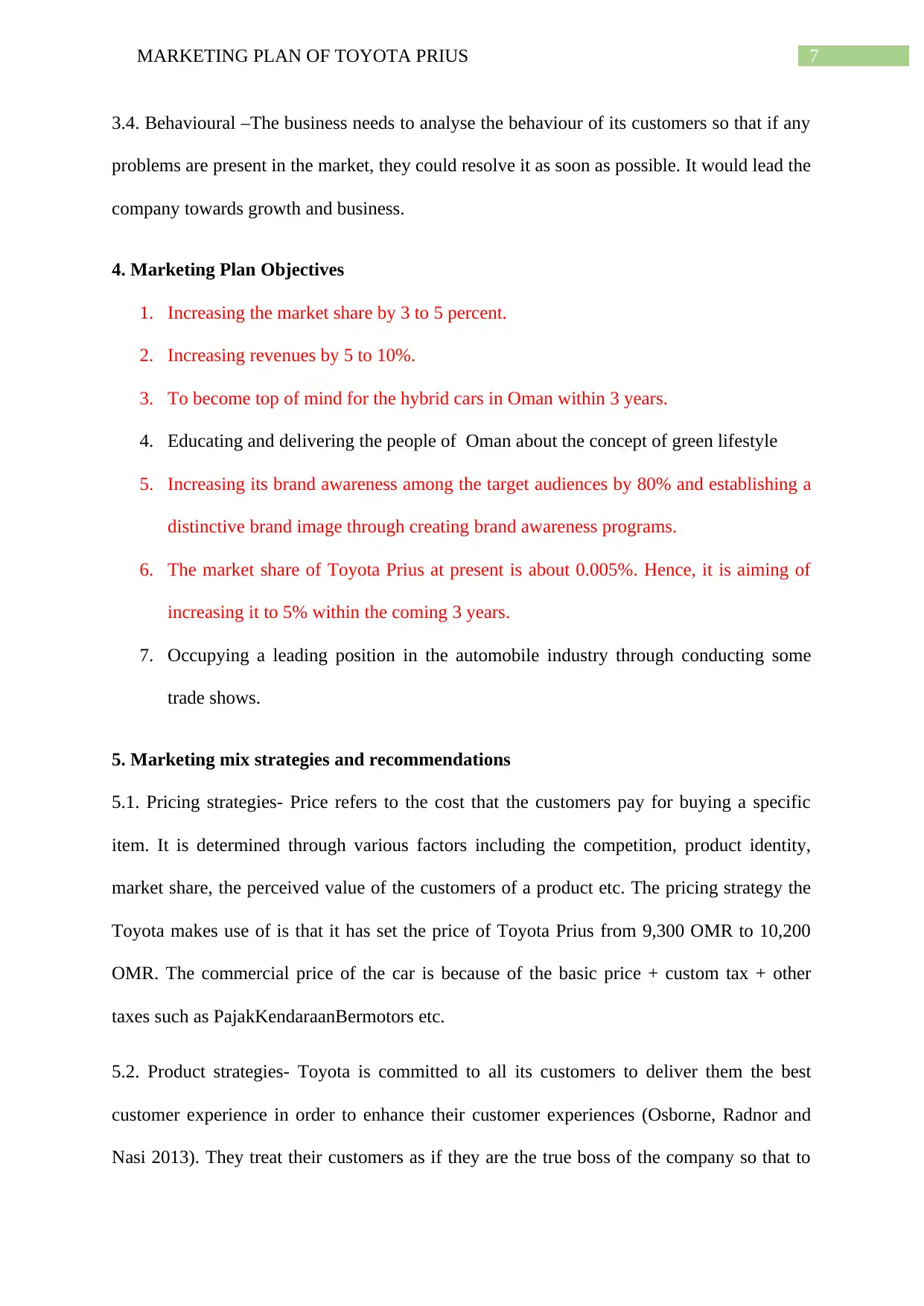
7MARKETING PLAN OF TOYOTA PRIUS
3.4. Behavioural –The business needs to analyse the behaviour of its customers so that if any
problems are present in the market, they could resolve it as soon as possible. It would lead the
company towards growth and business.
4. Marketing Plan Objectives
1. Increasing the market share by 3 to 5 percent.
2. Increasing revenues by 5 to 10%.
3. To become top of mind for the hybrid cars in Oman within 3 years.
4. Educating and delivering the people of Oman about the concept of green lifestyle
5. Increasing its brand awareness among the target audiences by 80% and establishing a
distinctive brand image through creating brand awareness programs.
6. The market share of Toyota Prius at present is about 0.005%. Hence, it is aiming of
increasing it to 5% within the coming 3 years.
7. Occupying a leading position in the automobile industry through conducting some
trade shows.
5. Marketing mix strategies and recommendations
5.1. Pricing strategies- Price refers to the cost that the customers pay for buying a specific
item. It is determined through various factors including the competition, product identity,
market share, the perceived value of the customers of a product etc. The pricing strategy the
Toyota makes use of is that it has set the price of Toyota Prius from 9,300 OMR to 10,200
OMR. The commercial price of the car is because of the basic price + custom tax + other
taxes such as PajakKendaraanBermotors etc.
5.2. Product strategies- Toyota is committed to all its customers to deliver them the best
customer experience in order to enhance their customer experiences (Osborne, Radnor and
Nasi 2013). They treat their customers as if they are the true boss of the company so that to
3.4. Behavioural –The business needs to analyse the behaviour of its customers so that if any
problems are present in the market, they could resolve it as soon as possible. It would lead the
company towards growth and business.
4. Marketing Plan Objectives
1. Increasing the market share by 3 to 5 percent.
2. Increasing revenues by 5 to 10%.
3. To become top of mind for the hybrid cars in Oman within 3 years.
4. Educating and delivering the people of Oman about the concept of green lifestyle
5. Increasing its brand awareness among the target audiences by 80% and establishing a
distinctive brand image through creating brand awareness programs.
6. The market share of Toyota Prius at present is about 0.005%. Hence, it is aiming of
increasing it to 5% within the coming 3 years.
7. Occupying a leading position in the automobile industry through conducting some
trade shows.
5. Marketing mix strategies and recommendations
5.1. Pricing strategies- Price refers to the cost that the customers pay for buying a specific
item. It is determined through various factors including the competition, product identity,
market share, the perceived value of the customers of a product etc. The pricing strategy the
Toyota makes use of is that it has set the price of Toyota Prius from 9,300 OMR to 10,200
OMR. The commercial price of the car is because of the basic price + custom tax + other
taxes such as PajakKendaraanBermotors etc.
5.2. Product strategies- Toyota is committed to all its customers to deliver them the best
customer experience in order to enhance their customer experiences (Osborne, Radnor and
Nasi 2013). They treat their customers as if they are the true boss of the company so that to
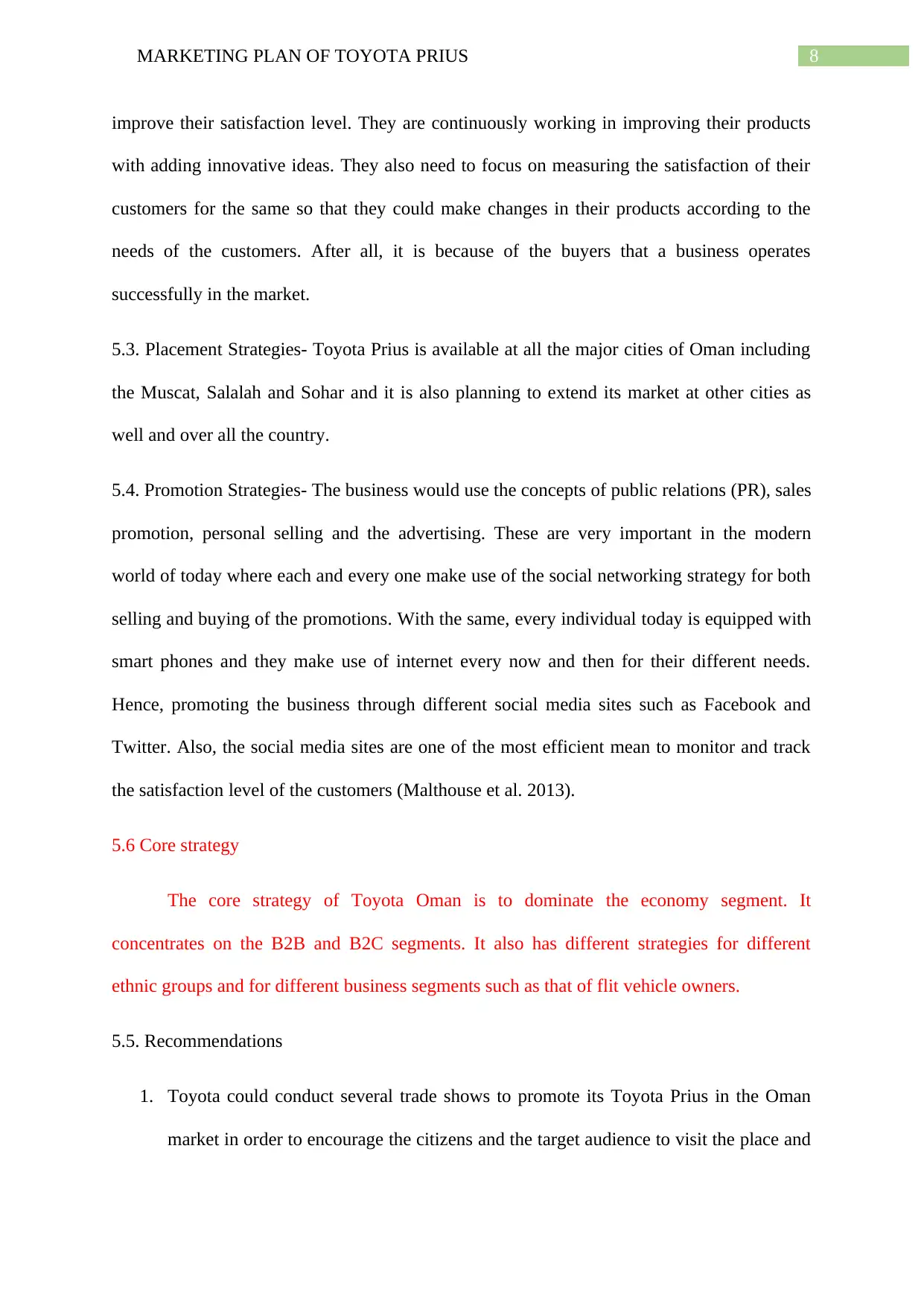
8MARKETING PLAN OF TOYOTA PRIUS
improve their satisfaction level. They are continuously working in improving their products
with adding innovative ideas. They also need to focus on measuring the satisfaction of their
customers for the same so that they could make changes in their products according to the
needs of the customers. After all, it is because of the buyers that a business operates
successfully in the market.
5.3. Placement Strategies- Toyota Prius is available at all the major cities of Oman including
the Muscat, Salalah and Sohar and it is also planning to extend its market at other cities as
well and over all the country.
5.4. Promotion Strategies- The business would use the concepts of public relations (PR), sales
promotion, personal selling and the advertising. These are very important in the modern
world of today where each and every one make use of the social networking strategy for both
selling and buying of the promotions. With the same, every individual today is equipped with
smart phones and they make use of internet every now and then for their different needs.
Hence, promoting the business through different social media sites such as Facebook and
Twitter. Also, the social media sites are one of the most efficient mean to monitor and track
the satisfaction level of the customers (Malthouse et al. 2013).
5.6 Core strategy
The core strategy of Toyota Oman is to dominate the economy segment. It
concentrates on the B2B and B2C segments. It also has different strategies for different
ethnic groups and for different business segments such as that of flit vehicle owners.
5.5. Recommendations
1. Toyota could conduct several trade shows to promote its Toyota Prius in the Oman
market in order to encourage the citizens and the target audience to visit the place and
improve their satisfaction level. They are continuously working in improving their products
with adding innovative ideas. They also need to focus on measuring the satisfaction of their
customers for the same so that they could make changes in their products according to the
needs of the customers. After all, it is because of the buyers that a business operates
successfully in the market.
5.3. Placement Strategies- Toyota Prius is available at all the major cities of Oman including
the Muscat, Salalah and Sohar and it is also planning to extend its market at other cities as
well and over all the country.
5.4. Promotion Strategies- The business would use the concepts of public relations (PR), sales
promotion, personal selling and the advertising. These are very important in the modern
world of today where each and every one make use of the social networking strategy for both
selling and buying of the promotions. With the same, every individual today is equipped with
smart phones and they make use of internet every now and then for their different needs.
Hence, promoting the business through different social media sites such as Facebook and
Twitter. Also, the social media sites are one of the most efficient mean to monitor and track
the satisfaction level of the customers (Malthouse et al. 2013).
5.6 Core strategy
The core strategy of Toyota Oman is to dominate the economy segment. It
concentrates on the B2B and B2C segments. It also has different strategies for different
ethnic groups and for different business segments such as that of flit vehicle owners.
5.5. Recommendations
1. Toyota could conduct several trade shows to promote its Toyota Prius in the Oman
market in order to encourage the citizens and the target audience to visit the place and
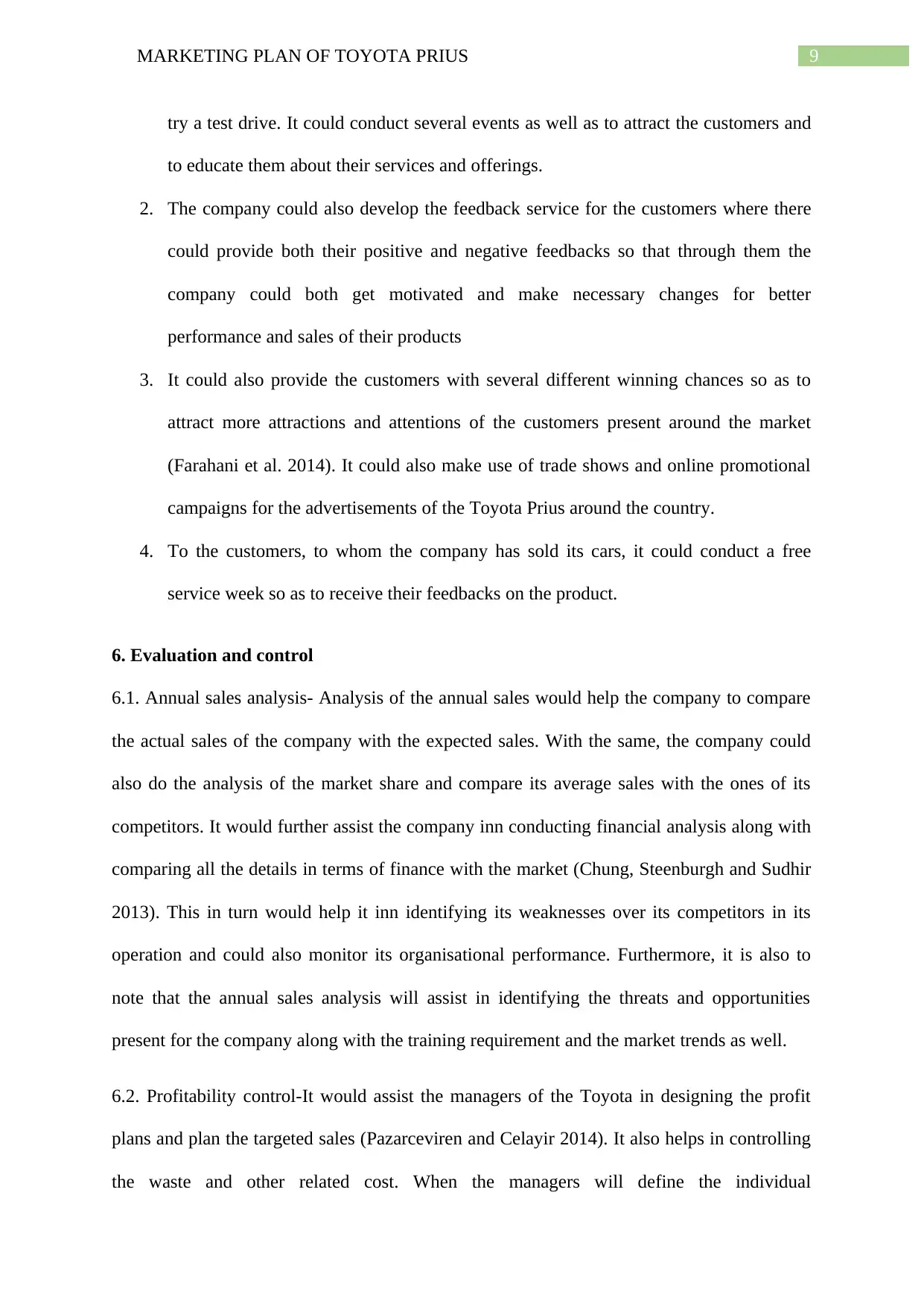
9MARKETING PLAN OF TOYOTA PRIUS
try a test drive. It could conduct several events as well as to attract the customers and
to educate them about their services and offerings.
2. The company could also develop the feedback service for the customers where there
could provide both their positive and negative feedbacks so that through them the
company could both get motivated and make necessary changes for better
performance and sales of their products
3. It could also provide the customers with several different winning chances so as to
attract more attractions and attentions of the customers present around the market
(Farahani et al. 2014). It could also make use of trade shows and online promotional
campaigns for the advertisements of the Toyota Prius around the country.
4. To the customers, to whom the company has sold its cars, it could conduct a free
service week so as to receive their feedbacks on the product.
6. Evaluation and control
6.1. Annual sales analysis- Analysis of the annual sales would help the company to compare
the actual sales of the company with the expected sales. With the same, the company could
also do the analysis of the market share and compare its average sales with the ones of its
competitors. It would further assist the company inn conducting financial analysis along with
comparing all the details in terms of finance with the market (Chung, Steenburgh and Sudhir
2013). This in turn would help it inn identifying its weaknesses over its competitors in its
operation and could also monitor its organisational performance. Furthermore, it is also to
note that the annual sales analysis will assist in identifying the threats and opportunities
present for the company along with the training requirement and the market trends as well.
6.2. Profitability control-It would assist the managers of the Toyota in designing the profit
plans and plan the targeted sales (Pazarceviren and Celayir 2014). It also helps in controlling
the waste and other related cost. When the managers will define the individual
try a test drive. It could conduct several events as well as to attract the customers and
to educate them about their services and offerings.
2. The company could also develop the feedback service for the customers where there
could provide both their positive and negative feedbacks so that through them the
company could both get motivated and make necessary changes for better
performance and sales of their products
3. It could also provide the customers with several different winning chances so as to
attract more attractions and attentions of the customers present around the market
(Farahani et al. 2014). It could also make use of trade shows and online promotional
campaigns for the advertisements of the Toyota Prius around the country.
4. To the customers, to whom the company has sold its cars, it could conduct a free
service week so as to receive their feedbacks on the product.
6. Evaluation and control
6.1. Annual sales analysis- Analysis of the annual sales would help the company to compare
the actual sales of the company with the expected sales. With the same, the company could
also do the analysis of the market share and compare its average sales with the ones of its
competitors. It would further assist the company inn conducting financial analysis along with
comparing all the details in terms of finance with the market (Chung, Steenburgh and Sudhir
2013). This in turn would help it inn identifying its weaknesses over its competitors in its
operation and could also monitor its organisational performance. Furthermore, it is also to
note that the annual sales analysis will assist in identifying the threats and opportunities
present for the company along with the training requirement and the market trends as well.
6.2. Profitability control-It would assist the managers of the Toyota in designing the profit
plans and plan the targeted sales (Pazarceviren and Celayir 2014). It also helps in controlling
the waste and other related cost. When the managers will define the individual
Secure Best Marks with AI Grader
Need help grading? Try our AI Grader for instant feedback on your assignments.
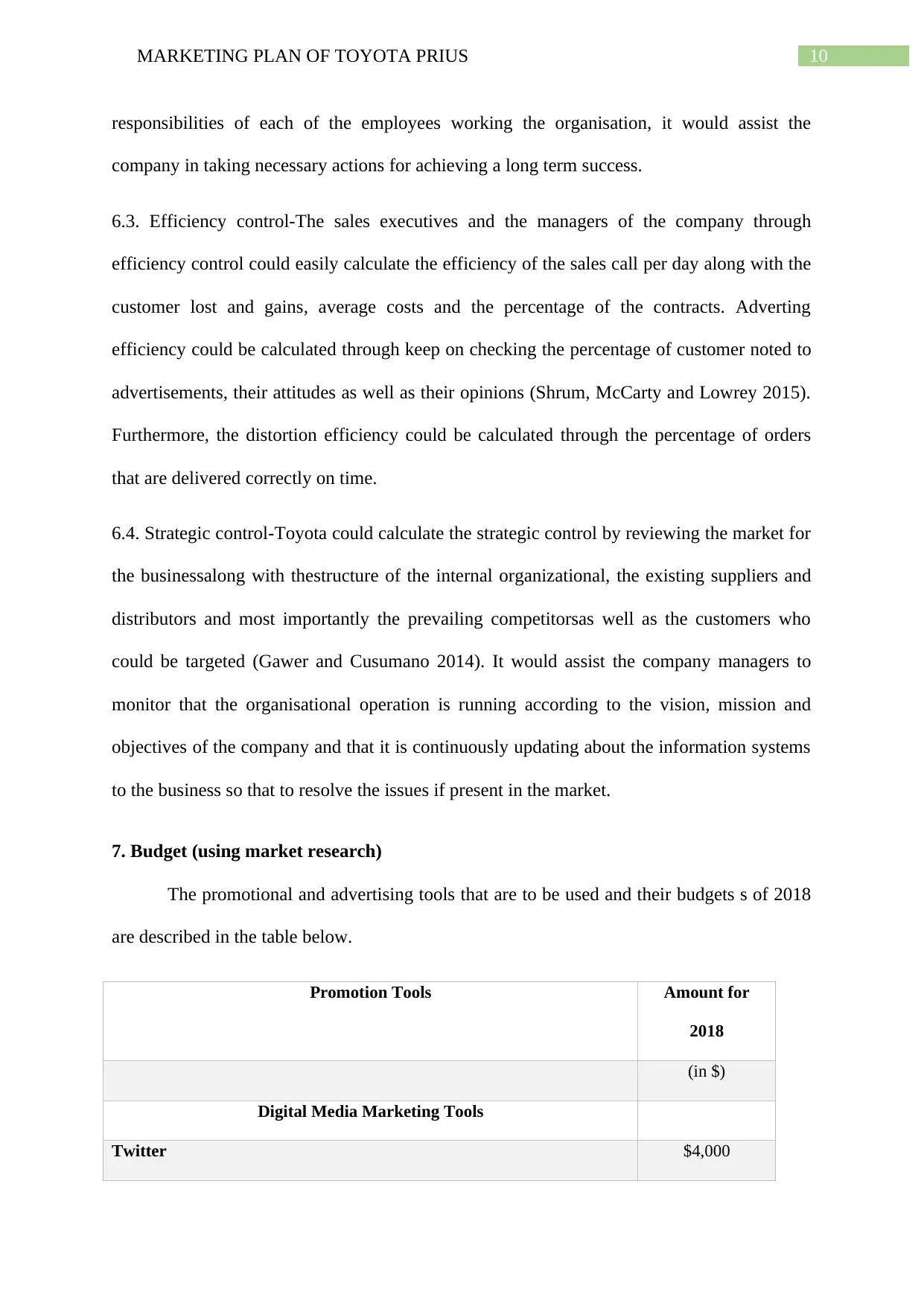
10MARKETING PLAN OF TOYOTA PRIUS
responsibilities of each of the employees working the organisation, it would assist the
company in taking necessary actions for achieving a long term success.
6.3. Efficiency control-The sales executives and the managers of the company through
efficiency control could easily calculate the efficiency of the sales call per day along with the
customer lost and gains, average costs and the percentage of the contracts. Adverting
efficiency could be calculated through keep on checking the percentage of customer noted to
advertisements, their attitudes as well as their opinions (Shrum, McCarty and Lowrey 2015).
Furthermore, the distortion efficiency could be calculated through the percentage of orders
that are delivered correctly on time.
6.4. Strategic control-Toyota could calculate the strategic control by reviewing the market for
the businessalong with thestructure of the internal organizational, the existing suppliers and
distributors and most importantly the prevailing competitorsas well as the customers who
could be targeted (Gawer and Cusumano 2014). It would assist the company managers to
monitor that the organisational operation is running according to the vision, mission and
objectives of the company and that it is continuously updating about the information systems
to the business so that to resolve the issues if present in the market.
7. Budget (using market research)
The promotional and advertising tools that are to be used and their budgets s of 2018
are described in the table below.
Promotion Tools Amount for
2018
(in $)
Digital Media Marketing Tools
Twitter $4,000
responsibilities of each of the employees working the organisation, it would assist the
company in taking necessary actions for achieving a long term success.
6.3. Efficiency control-The sales executives and the managers of the company through
efficiency control could easily calculate the efficiency of the sales call per day along with the
customer lost and gains, average costs and the percentage of the contracts. Adverting
efficiency could be calculated through keep on checking the percentage of customer noted to
advertisements, their attitudes as well as their opinions (Shrum, McCarty and Lowrey 2015).
Furthermore, the distortion efficiency could be calculated through the percentage of orders
that are delivered correctly on time.
6.4. Strategic control-Toyota could calculate the strategic control by reviewing the market for
the businessalong with thestructure of the internal organizational, the existing suppliers and
distributors and most importantly the prevailing competitorsas well as the customers who
could be targeted (Gawer and Cusumano 2014). It would assist the company managers to
monitor that the organisational operation is running according to the vision, mission and
objectives of the company and that it is continuously updating about the information systems
to the business so that to resolve the issues if present in the market.
7. Budget (using market research)
The promotional and advertising tools that are to be used and their budgets s of 2018
are described in the table below.
Promotion Tools Amount for
2018
(in $)
Digital Media Marketing Tools
Twitter $4,000
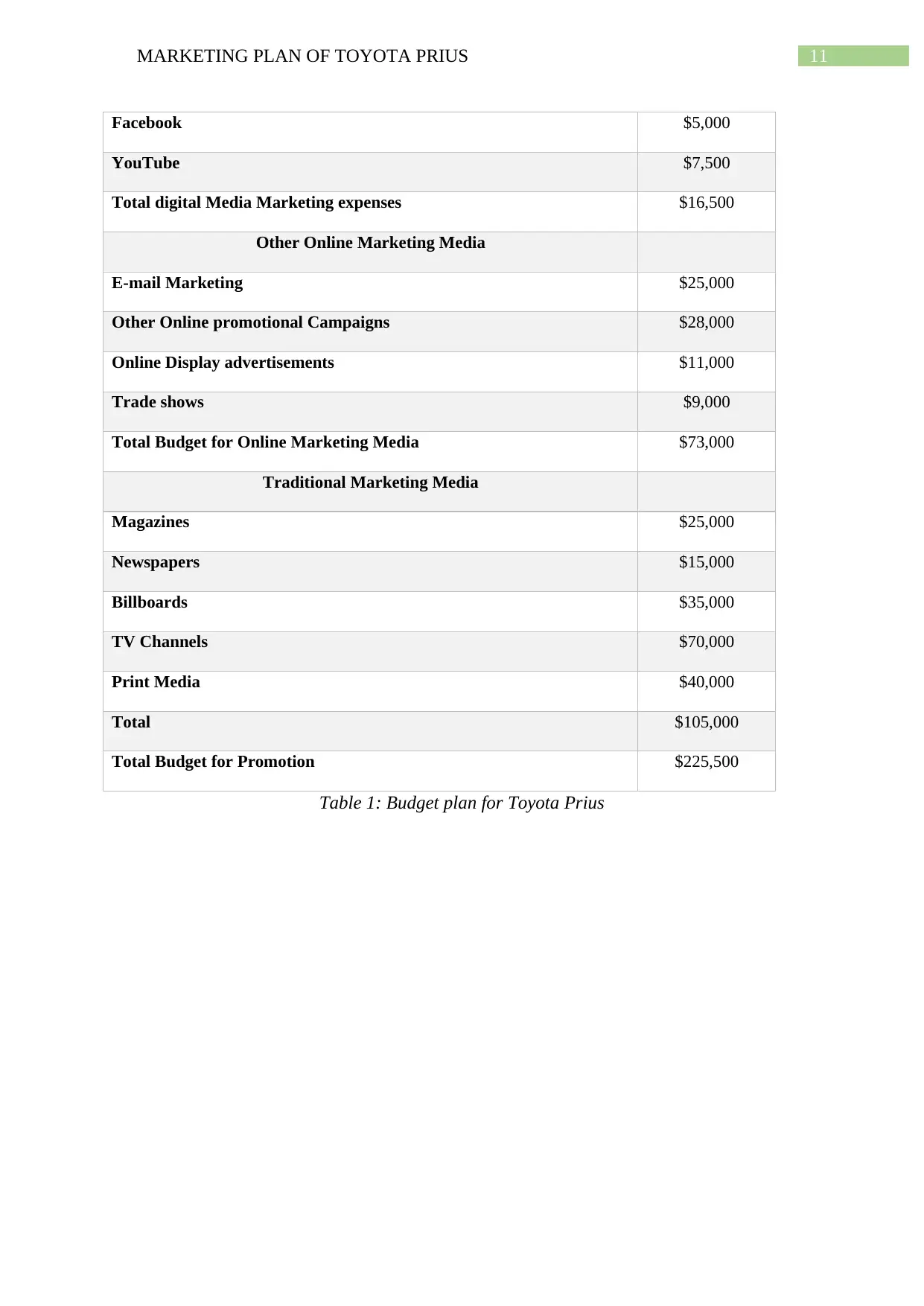
11MARKETING PLAN OF TOYOTA PRIUS
Facebook $5,000
YouTube $7,500
Total digital Media Marketing expenses $16,500
Other Online Marketing Media
E-mail Marketing $25,000
Other Online promotional Campaigns $28,000
Online Display advertisements $11,000
Trade shows $9,000
Total Budget for Online Marketing Media $73,000
Traditional Marketing Media
Magazines $25,000
Newspapers $15,000
Billboards $35,000
TV Channels $70,000
Print Media $40,000
Total $105,000
Total Budget for Promotion $225,500
Table 1: Budget plan for Toyota Prius
Facebook $5,000
YouTube $7,500
Total digital Media Marketing expenses $16,500
Other Online Marketing Media
E-mail Marketing $25,000
Other Online promotional Campaigns $28,000
Online Display advertisements $11,000
Trade shows $9,000
Total Budget for Online Marketing Media $73,000
Traditional Marketing Media
Magazines $25,000
Newspapers $15,000
Billboards $35,000
TV Channels $70,000
Print Media $40,000
Total $105,000
Total Budget for Promotion $225,500
Table 1: Budget plan for Toyota Prius

12MARKETING PLAN OF TOYOTA PRIUS
9. References
Buckingham, L. and Al-Athwary, A., 2016. Commercial signs in Oman and Yemen: A study
of street advertising in English. Language, Identity and Education on the Arabian Peninsula:
Bilingual Policies in a Multilingual Context, 166, p.59.
Chung, D.J., Steenburgh, T. and Sudhir, K., 2013. Do bonuses enhance sales productivity? A
dynamic structural analysis of bonus-based compensation plans. Marketing Science, 33(2),
pp.165-187.
Danese, P., Romano, P. and Formentini, M., 2013. The impact of supply chain integration on
responsiveness: The moderating effect of using an international supplier
network. Transportation Research Part E: Logistics and Transportation Review, 49(1),
pp.125-140.
El-Refaie, A.M., 2013. Motors/generators for traction/propulsion applications: A
review. IEEE Vehicular Technology Magazine, 8(1), pp.90-99.
Eneizan, B.M., Wahab, K.A., Zainon, M.S. and Obaid, T.F., 2016. Effects of Green
Marketing Strategy on the Financial and Non-Financial Performance of Firms: A Conceptual
Paper. Arabian Journal of Business and Management Review (Oman Chapter), 5(12), p.14.
Farahani, R.Z., Rezapour, S., Drezner, T. and Fallah, S., 2014. Competitive supply chain
network design: An overview of classifications, models, solution techniques and
applications. Omega, 45, pp.92-118.
9. References
Buckingham, L. and Al-Athwary, A., 2016. Commercial signs in Oman and Yemen: A study
of street advertising in English. Language, Identity and Education on the Arabian Peninsula:
Bilingual Policies in a Multilingual Context, 166, p.59.
Chung, D.J., Steenburgh, T. and Sudhir, K., 2013. Do bonuses enhance sales productivity? A
dynamic structural analysis of bonus-based compensation plans. Marketing Science, 33(2),
pp.165-187.
Danese, P., Romano, P. and Formentini, M., 2013. The impact of supply chain integration on
responsiveness: The moderating effect of using an international supplier
network. Transportation Research Part E: Logistics and Transportation Review, 49(1),
pp.125-140.
El-Refaie, A.M., 2013. Motors/generators for traction/propulsion applications: A
review. IEEE Vehicular Technology Magazine, 8(1), pp.90-99.
Eneizan, B.M., Wahab, K.A., Zainon, M.S. and Obaid, T.F., 2016. Effects of Green
Marketing Strategy on the Financial and Non-Financial Performance of Firms: A Conceptual
Paper. Arabian Journal of Business and Management Review (Oman Chapter), 5(12), p.14.
Farahani, R.Z., Rezapour, S., Drezner, T. and Fallah, S., 2014. Competitive supply chain
network design: An overview of classifications, models, solution techniques and
applications. Omega, 45, pp.92-118.
Paraphrase This Document
Need a fresh take? Get an instant paraphrase of this document with our AI Paraphraser
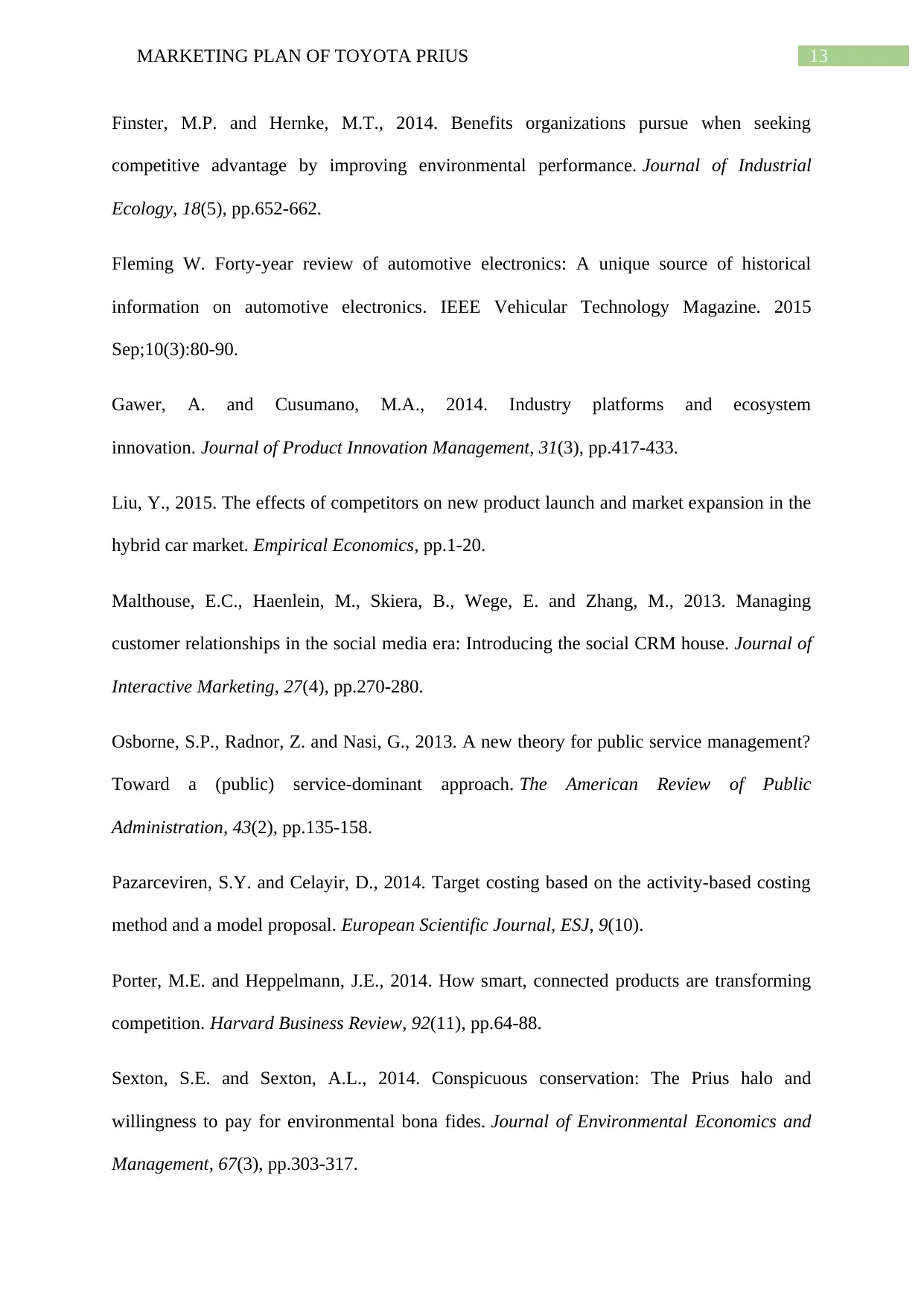
13MARKETING PLAN OF TOYOTA PRIUS
Finster, M.P. and Hernke, M.T., 2014. Benefits organizations pursue when seeking
competitive advantage by improving environmental performance. Journal of Industrial
Ecology, 18(5), pp.652-662.
Fleming W. Forty-year review of automotive electronics: A unique source of historical
information on automotive electronics. IEEE Vehicular Technology Magazine. 2015
Sep;10(3):80-90.
Gawer, A. and Cusumano, M.A., 2014. Industry platforms and ecosystem
innovation. Journal of Product Innovation Management, 31(3), pp.417-433.
Liu, Y., 2015. The effects of competitors on new product launch and market expansion in the
hybrid car market. Empirical Economics, pp.1-20.
Malthouse, E.C., Haenlein, M., Skiera, B., Wege, E. and Zhang, M., 2013. Managing
customer relationships in the social media era: Introducing the social CRM house. Journal of
Interactive Marketing, 27(4), pp.270-280.
Osborne, S.P., Radnor, Z. and Nasi, G., 2013. A new theory for public service management?
Toward a (public) service-dominant approach. The American Review of Public
Administration, 43(2), pp.135-158.
Pazarceviren, S.Y. and Celayir, D., 2014. Target costing based on the activity-based costing
method and a model proposal. European Scientific Journal, ESJ, 9(10).
Porter, M.E. and Heppelmann, J.E., 2014. How smart, connected products are transforming
competition. Harvard Business Review, 92(11), pp.64-88.
Sexton, S.E. and Sexton, A.L., 2014. Conspicuous conservation: The Prius halo and
willingness to pay for environmental bona fides. Journal of Environmental Economics and
Management, 67(3), pp.303-317.
Finster, M.P. and Hernke, M.T., 2014. Benefits organizations pursue when seeking
competitive advantage by improving environmental performance. Journal of Industrial
Ecology, 18(5), pp.652-662.
Fleming W. Forty-year review of automotive electronics: A unique source of historical
information on automotive electronics. IEEE Vehicular Technology Magazine. 2015
Sep;10(3):80-90.
Gawer, A. and Cusumano, M.A., 2014. Industry platforms and ecosystem
innovation. Journal of Product Innovation Management, 31(3), pp.417-433.
Liu, Y., 2015. The effects of competitors on new product launch and market expansion in the
hybrid car market. Empirical Economics, pp.1-20.
Malthouse, E.C., Haenlein, M., Skiera, B., Wege, E. and Zhang, M., 2013. Managing
customer relationships in the social media era: Introducing the social CRM house. Journal of
Interactive Marketing, 27(4), pp.270-280.
Osborne, S.P., Radnor, Z. and Nasi, G., 2013. A new theory for public service management?
Toward a (public) service-dominant approach. The American Review of Public
Administration, 43(2), pp.135-158.
Pazarceviren, S.Y. and Celayir, D., 2014. Target costing based on the activity-based costing
method and a model proposal. European Scientific Journal, ESJ, 9(10).
Porter, M.E. and Heppelmann, J.E., 2014. How smart, connected products are transforming
competition. Harvard Business Review, 92(11), pp.64-88.
Sexton, S.E. and Sexton, A.L., 2014. Conspicuous conservation: The Prius halo and
willingness to pay for environmental bona fides. Journal of Environmental Economics and
Management, 67(3), pp.303-317.
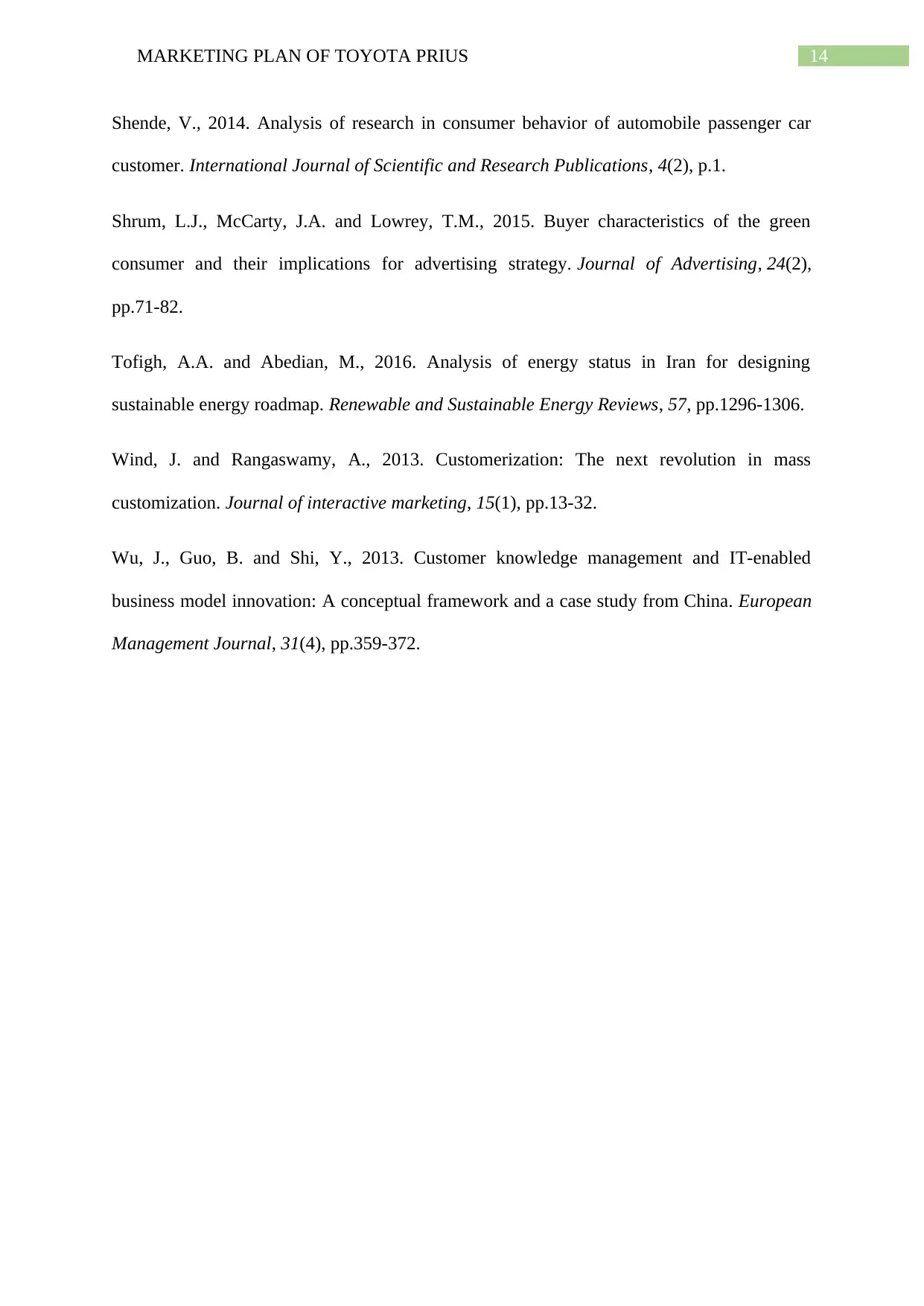
14MARKETING PLAN OF TOYOTA PRIUS
Shende, V., 2014. Analysis of research in consumer behavior of automobile passenger car
customer. International Journal of Scientific and Research Publications, 4(2), p.1.
Shrum, L.J., McCarty, J.A. and Lowrey, T.M., 2015. Buyer characteristics of the green
consumer and their implications for advertising strategy. Journal of Advertising, 24(2),
pp.71-82.
Tofigh, A.A. and Abedian, M., 2016. Analysis of energy status in Iran for designing
sustainable energy roadmap. Renewable and Sustainable Energy Reviews, 57, pp.1296-1306.
Wind, J. and Rangaswamy, A., 2013. Customerization: The next revolution in mass
customization. Journal of interactive marketing, 15(1), pp.13-32.
Wu, J., Guo, B. and Shi, Y., 2013. Customer knowledge management and IT-enabled
business model innovation: A conceptual framework and a case study from China. European
Management Journal, 31(4), pp.359-372.
Shende, V., 2014. Analysis of research in consumer behavior of automobile passenger car
customer. International Journal of Scientific and Research Publications, 4(2), p.1.
Shrum, L.J., McCarty, J.A. and Lowrey, T.M., 2015. Buyer characteristics of the green
consumer and their implications for advertising strategy. Journal of Advertising, 24(2),
pp.71-82.
Tofigh, A.A. and Abedian, M., 2016. Analysis of energy status in Iran for designing
sustainable energy roadmap. Renewable and Sustainable Energy Reviews, 57, pp.1296-1306.
Wind, J. and Rangaswamy, A., 2013. Customerization: The next revolution in mass
customization. Journal of interactive marketing, 15(1), pp.13-32.
Wu, J., Guo, B. and Shi, Y., 2013. Customer knowledge management and IT-enabled
business model innovation: A conceptual framework and a case study from China. European
Management Journal, 31(4), pp.359-372.
1 out of 15
Related Documents
Your All-in-One AI-Powered Toolkit for Academic Success.
+13062052269
info@desklib.com
Available 24*7 on WhatsApp / Email
![[object Object]](/_next/static/media/star-bottom.7253800d.svg)
Unlock your academic potential
© 2024 | Zucol Services PVT LTD | All rights reserved.





